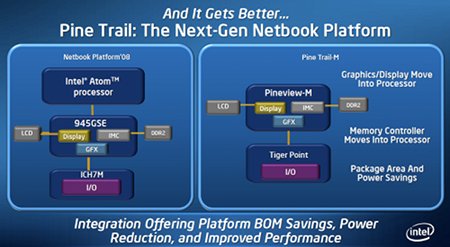Intel spins next-gen Atoms for netbooks
Sep 25, 2009 — by LinuxDevices Staff — from the LinuxDevices Archive — viewsIntel will ship a new generation of Atom processors, code-named “Pineview,” during the fourth quarter of this year, according to an IDG News Service report. The CPUs — known as the Atom N450, D410, and D510 — will extend netbook battery life and allow HD video playback, among other previously cited advantages.
As we report below, the Pineview CPUs have been expected for some time. Noury Al-Khaledy, Intel's GM for netbooks and nettops, provided initial details in a May conference call that was mostly devoted to announcing the chipmaker's Moblin 2.0 operating system. Since then, further details have been leaked by Taiwanese hardware vendors.
Until now, availability details have been lacking. In a report from this week's Intel Developer Forum (IDF), however, IDG News Service writer Agam Shah quotes Intel official Jeff DeMuth as saying Pineview chips will ship to manufacturers in the fourth quarter. Though DeMuth reportedly declined to comment on when Pineview-equipped netbooks could reach consumers, we'd expect the new, power-sipping devices to materialize during the first quarter of 2010.
According to Intel, its overall "Pine Trail" platform shrinks the number of chips required to develop an Atom-based device down to two: the "Pineview" CPU package, plus an I/O controller called "Tiger Point." The chipmaker hasn't released names for the products, but previous reports by Digitimes and HKEPC Hardware says the Pineview processors will include the 1.66GHz Atom N450, a single-core offering for netbooks, plus the 1.66GHz Atom D410 and Atom D510, nettop processors with single and dual cores, respectively. Tiger Point, designed to accompany them all, will be marketed as the NM10.
The N450 is designed to replace Intel's N270 — the "chip that launched a thousand netbooks." The D410 and D510, meanwhile, are designed to replace the Atom 230 and Atom 330, respectively.

Intel's upcoming Pine Trail chipset
Source: Intel
(Click to enlarge)
According to Al-Khaledy, Pine Trail will bring the Atom's memory controller and graphics core on-die, as pictured above, improving performance and significantly reducing thermal output. While the Atom N450 itself provides northbridge functionality, I/O is handled by the relatively simple NM10.
Better battery life and faster graphics
HKEPC Hardware, citing multiple PC manufacturers as sources, has claimed the N450 will be the same size as the N270, with a BGA (ball grid array) size of 22 x 22m. But the NM10 I/O controller will measure just 17 x 17mm, saving substantial board real estate.
Even more important, the Pine Trail platform will have a seven-Watt TDP and require an average of just two Watts, says HKEPC. Comparing these numbers to the N270's "Diamondville" platform — for which it cites slightly higher power requirements than we quote below — the website says that Pine Trail offers at least 50 percent lower power consumption. As a result, forthcoming netbooks should be able to offer significantly better battery life.
HKEPC didn't offer power consumption figures for the N450's nettop cousins, the D410 and D510, but it did suggest that all Pineview CPUs will outperform their predecessors. Reportedly more important than the miniscule .06GHz bump in clock speed will be a move to 667MHz memory, plus, on the D510, a doubling of second-level cache to 1MB.
HKEPC also claims that the Pine Trail platform will move from Intel's GMA950 integrated graphics to the chipmaker's somewhat-more-adept GMA500 IGP (integrated graphics processor), taking IGP clock speed from 133MHz to 200MHz. If true, this could make Atom-based netbooks capable of playing full HD video. The GMA500, based on Imagination Technologies' Powervr SGX535, is already featured in Intel's newly announced Atom SoC, the CE4100, where it's claimed to handle 1080p video streams with ease.
Background
Intel's first-ever Atom processors, the Z5xx chips that were originally code-named "Silverthorne," already offer a two-chip solution, since they were released from the start as 14 x 13mm CPUs designed to operate with the 22 x 22mm SCH US15W ("Poulsbo") companion chip. But, while these Z5xx CPUs have shown up in MIDs (mobile internet devices), a variety of embedded devices, and a few mini-notebooks, the majority of netbooks and nettops employ the N270 and 230, aka "Diamondville." Architecturally identical to the Z5xx series, these are 22mm x 22mm CPUs that were designed to be more affordable, and rely on separate northbridge and southbridge chips — known collectively as the 945GSE for the N270, and 945GC for its desktop cousin.
While the N270 itself has a modest TDP of just two Watts, its 945GSE (945GCSE northbridge and 82801GBM southbridge) chipset chews up another six Watts. In contrast, Silverthorne and Poulsbo together use just 4.5 Watts, delivering improved battery life. However, while the N270 reportedly costs manufacturers around $46, the Z530/SCH US15W solution is said to cost them $95.
Pine Trail, with its Pineview CPU and Tiger Point I/O controller, then, seems to be an attempt to provide customers with fanless operation and lower power consumption, but at a lower price. Pine Trail will apparently use a 45nm production process throughout, unlike the Diamondville platform, which uses 45nm for the CPU but 130nm for its supporting chips.
Power-stingy though it might be, Pine Trail pales beside Intel's forthcoming "Moorestown" platform, which was first promised in a Sep. 2007 Intel Developer Forum keynote, and is claimed to offer an idle power consumption just 1/10th of today's Atoms. According to Intel, Moorestown will go on sale in 2010, targeting smartphones and MIDs, where it will apparently replace the original Z5xx CPUs.
Availability
To see the IDG News Service report about Pine Trail availability, see the PC World website, here.
For our previous Pine Trail coverage, including links to the referenced Digitimes and HKEPC Hardware stories, see here.
This article was originally published on LinuxDevices.com and has been donated to the open source community by QuinStreet Inc. Please visit LinuxToday.com for up-to-date news and articles about Linux and open source.